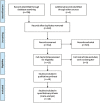Influence of Ketorolac Supplementation on Pain Control for Knee Arthroscopy: A Meta-Analysis of Randomized Controlled Trials
- PMID: 32077265
- PMCID: PMC7031550
- DOI: 10.1111/os.12608
Influence of Ketorolac Supplementation on Pain Control for Knee Arthroscopy: A Meta-Analysis of Randomized Controlled Trials
Abstract
Introduction: The efficacy of ketorolac supplementation on pain control for knee arthroscopy remains controversial. We conduct a systematic review and meta-analysis to explore the impact of ketorolac supplementation on pain intensity after knee arthroscopy.
Methods: We search PubMed, EMbase, Web of science, EBSCO, and Cochrane library databases through September 2018 for randomized controlled trials (RCTs) assessing the effect of ketorolac supplementation vs placebo on pain management after knee arthroscopy. This meta-analysis is performed using the random-effect model.
Results: Ten RCTs involving 402 patients are included in the meta-analysis. Overall, compared with control group for knee arthroscopy, ketorolac supplementation is associated with notably reduced pain scores at 1 h (MD = -0.66; 95% CI = -1.12 to -0.21; P = 0.004) and 2 h (MD = -0.90; 95% CI = -1.74 to -0.07; P = 0.03), prolonged time for first analgesic requirement (MD = 1.94; 95% CI = 0.33 to 3.55; P = 0.02) and decreased number of analgesic requirement (RR = 0.41; 95% CI = 0.23 to 0.75; P = 0.003), but has no obvious impact on analgesic consumption (MD = -0.56; 95% CI = -1.14 to 0.02; P = 0.06), as well as nausea and vomiting (RR = 0.44; 95% CI = 0.12 to 0.21; P = 0.21).
Conclusions: Ketorolac supplementation is effective to produce pain relief for knee arthroscopy.
Keywords: ketorolac supplementation; knee arthroscopy; meta-analysis; pain control; randomized controlled trials.
© 2020 The Authors. Orthopaedic Surgery published by Chinese Orthopaedic Association and John Wiley & Sons Australia, Ltd.
Figures







Similar articles
-
The efficacy of dexamethasone on pain management for knee arthroscopy: A meta-analysis of randomized controlled trials.Medicine (Baltimore). 2020 Apr;99(16):e19417. doi: 10.1097/MD.0000000000019417. Medicine (Baltimore). 2020. PMID: 32311920 Free PMC article.
-
The efficacy of intra-articular fentanyl supplementation for knee arthroscopy: A meta-analysis of randomized controlled studies.J Orthop Surg (Hong Kong). 2020 Jan-Apr;28(1):2309499019900274. doi: 10.1177/2309499019900274. J Orthop Surg (Hong Kong). 2020. PMID: 31994976
-
The efficacy of ketamine supplementation on pain management for knee arthroscopy: A meta-analysis of randomized controlled trials.Medicine (Baltimore). 2019 Jul;98(27):e16138. doi: 10.1097/MD.0000000000016138. Medicine (Baltimore). 2019. PMID: 31277113 Free PMC article.
-
The efficacy of celecoxib for pain management of arthroscopy: A meta-analysis of randomized controlled trials.Medicine (Baltimore). 2019 Dec;98(49):e17808. doi: 10.1097/MD.0000000000017808. Medicine (Baltimore). 2019. PMID: 31804304 Free PMC article.
-
The efficacy and safety of ketorolac for postoperative pain management in lumbar spine surgery: a meta-analysis of randomized controlled trials.Syst Rev. 2024 Nov 5;13(1):275. doi: 10.1186/s13643-024-02685-z. Syst Rev. 2024. PMID: 39501393 Free PMC article.
Cited by
-
Efficacy of intra-articular ketorolac for pain control in arthroscopic surgeries: a systematic review and meta-analysis.J Orthop Surg Res. 2021 Nov 22;16(1):688. doi: 10.1186/s13018-021-02833-4. J Orthop Surg Res. 2021. PMID: 34809647 Free PMC article.
References
-
- Wojahn RD, Bogunovic L, Brophy RH, et al Opioid consumption after knee arthroscopy. J Bone Joint Surg Am, 2018, 100: 1629–1636. - PubMed
-
- Jacobson E, Forssblad M, Weidenhielm L, Renstrom P. Knee arthroscopy with the use of local anesthesia—an increased risk for repeat arthroscopy? A prospective, randomized study with a six‐month follow‐up. Am J Sports Med, 2002, 30: 61–65. - PubMed
Publication types
MeSH terms
Substances
LinkOut - more resources
Full Text Sources
Medical

